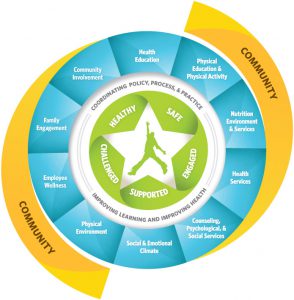
Healthy Students are Better Learners
Schools have direct contact with more than 95% of our nation’s young people aged 5-17 years, for about six hours per day and up to 13 critical years of their social, psychological, physical, and intellectual development. Schools play an important role in promoting the health and safety of children and adolescents by helping them to establish lifelong health patterns.
Healthy students are better learners, and academic achievement bears a lifetime of benefits for health. Schools are an ideal setting to teach and provide students with opportunities to improve their dietary and physical activity behaviors and manage their chronic health conditions (asthma, diabetes, epilepsy, food allergies, and poor oral health). When policies and practices are put in place to support healthy school environments, healthy students can grow to be healthy and successful adults.
Purpose and Outcomes of the Project
Short-Term Outcomes (1-3 years)
- Increased number of schools with an action plan based on completion of the School Health Index (SHI).
- Increased implementation of evidence-based Comprehensive School Physical Activity Programs (CSPAP).
- Increased implementation of evidence-based school nutrition and food security policies and practices.
- Increased implementation of evidence-based health services, policies, and practices that support students with chronic health conditions.
Intermediate Outcomes (3-5 years)
- Increased physical activity among students in priority local education agency (LEA) and corresponding schools.
- Increased healthy dietary behaviors among students in priority LEA and corresponding schools.
- Increased self-management of chronic health conditions among students in priority LEA and corresponding schools.
Long-Term Outcomes (5 or more years)
- Decreased overweight and obesity among students.
- Increased emotional well-being among students.
- Improved academic achievement among students.
- Reduced health disparities among students in underserved and disproportionately affected communities.
Funding

The project is made possible through a five-year federal grant entitled, “School-Based Interventions to Promote Equity and Improve Health, Academic Achievement, and Well-Being of Students,” through the Centers for Disease Control and Prevention (CDC), Division of Population Health, School Health Branch. More information can be found at CDC Healthy Schools.
The Healthy Schools Grant provides NM an opportunity to build and enhance infrastructure and capacity within our state in order to strengthen:
- Physical Activity
- Physical Education
- Health Education
- Nutrition
- Management of Chronic Disease in Schools
… as a pathway to academic success through a targeted, statewide approach through the coordinated school health model.
Additional Resources
New Mexico Childhood Obesity 2023 Update
Our school district partner for this this grant is:
Roswell Independent School District
National Technical Assistance is provided through a number of prominent organizations:
American Academy of Pediatrics (AAP)
National Association of School Nurses (NASN)
National Association of Chronic Disease Directors (NACDD)
The University of Maryland School of Medicine National Center for School Mental Health (NCSMH)
Education Development Center (EDC)
Society of Health and Physical Educators – SHAPE America
Local Partners provide support and resources in improved nutrition and increasing physical activity opportunities during and after school as well as assisting in program data collection and evaluation.
New Mexico Department of Health-Obesity, Nutrition and Physical Activity (ONAPA) Program
Healthy Kids, Healthy Communities NM
University of New Mexico Prevention Resource Center
New Mexico Youth Risk and Resiliency Survey (YRRS)
New Mexico Out of School Time (NMOST) Network
Guidance and Reference Documents
- Comprehensive Framework for Addressing the School Environment and Services
- School Health Guidelines to Promote Eating and Physical Activity
Youth Health Resources
Healthy Youth site, CDC The CDC’s Division of Adolescent and School Health is excited to announce that the Healthy Youth website has a new look.
The New Mexico Youth Risk and Resiliency Survey (YRRS) is a tool to assess the health risk behaviors and resiliency (protective) factors of New Mexico high school and middle school students. Topic areas for the YRRS include risk behaviors related to alcohol and drug use, unintentional injury, violence, suicidal ideation and attempts, tobacco use, sexual activity, physical activity, and nutrition; resiliency (protective) factors such as relationships in the family, school, community, and with peers; and health status issues such as body weight and asthma.
For more information, please contact
Micayla Durán
micayla.duran@ped.nm.gov
Healthy Schools Coordinator
New Mexico Public Education Department
